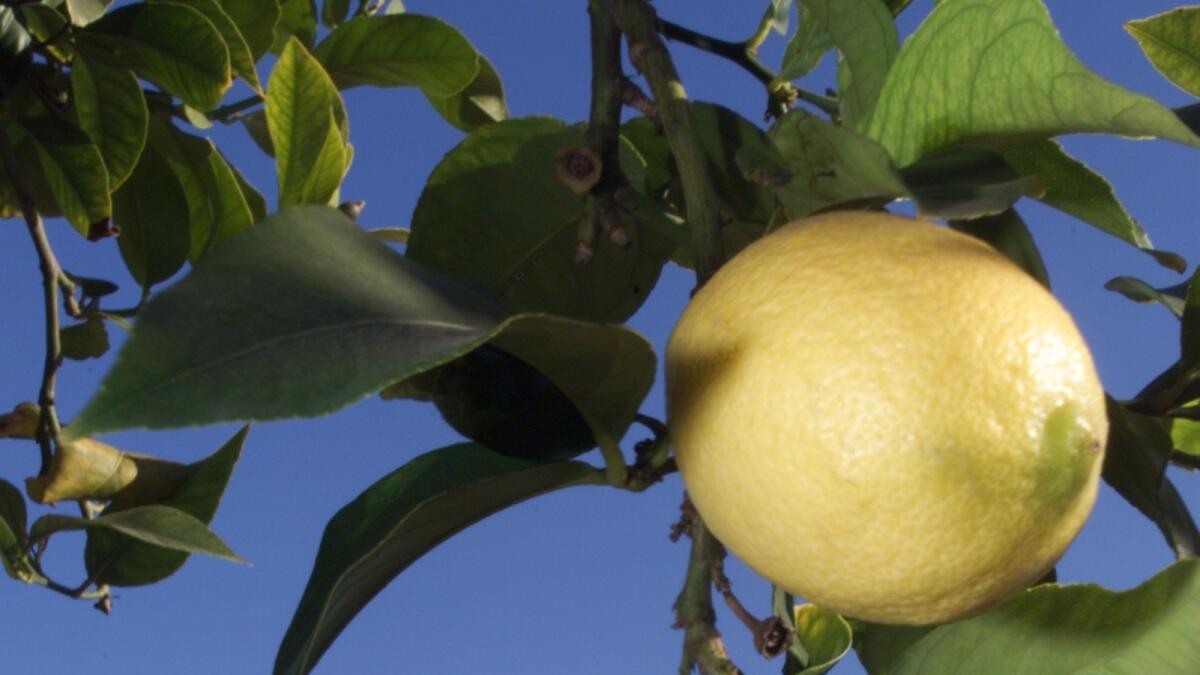Lemon growers feel squeezed by plan for Argentine imports

California lemon growers and their allies are seeking reinforcements in their campaign against proposed imports from Argentina.
Now both sides in this international citrus clash will get more time to rally. This week, the U.S. Department of Agriculture extended until Aug. 10 a public comment period that has already revealed deep anxiety within the U.S. lemon industry.
“We do not need any more problems with disease and unknown chemicals on imported fruit,” said Lyle Neutz, a resident of Tulare County in California’s San Joaquin Valley.
Neutz’s emailed comment was one of 150 the USDA had received through Monday, the original deadline. Many commenters voiced opposition, often using identical language.
“We need to know more about Argentina’s production practices, pests and disease risks before we let their growers ship to the U.S.,” said Dan Adams, a citrus grower from the Tulare County community of Visalia.
This proposed rule is the result of more than 10 years of technical negotiations between the U.S. and Argentina.
— Jose F.F. Carbonell, president of the Argentina Citrus Federation
Argentina’s advocates, too, have been planting comments in hopes of swaying USDA officials, who must make a diplomatically and politically charged decision.
“This proposed rule is the result of more than 10 years of technical negotiations between the U.S. and Argentina to provide the import authorization with the scientific support that this trade decision needs to be based on,” said Jose F.F. Carbonell, president of the Argentina Citrus Federation.
Carbonell noted that Argentine lemons would be shipped during the off-season for U.S. growers, providing “the U.S. consumer with a more stable supply year-round.” The Argentine lemons would primarily enter the United States between April 1 and Aug. 31, according to the USDA. The marketing season for California lemons runs year-round and the Arizona lemon season runs from September to March, according to the department.
California producers account for about 92% of commercial U.S. lemon production, and Arizona growers about 8%. The U.S. lemon crop was valued at $647 million in the 2013-14 season, the most recent year cited by the USDA.
Under a USDA proposal made public in May, lemons from northwest Argentina would be admitted to the United States if produced and handled in a designated manner. The proposal specifies registration, monitoring, pest control and harvesting requirements, among others.
An average of nearly 20,000 tons of lemons from Argentina probably would enter the United States each year, according to the USDA. U.S. lemon production averaged nearly 548,235 tons annually from 2008 to 2013.
“The price decline would be about 2%” for U.S. consumers, the USDA estimated.
Not for the first time, Congress has been drawn into the fight.
“I have heard from a number of Arizona residents and citrus farmers who have serious concerns about the impact this rule, if enacted, would have,” said Sen. John McCain (R-Ariz.).
The California growers have likewise been forwarding their concerns to their respective members of Congress.
In 2000, the Bill Clinton administration riled California farmers and the state’s congressional delegation by lifting an earlier ban on Argentina’s citrus. Some growers sued, and the ban was reimposed in 2001.
Argentina officials, in turn, filed a dispute in 2012 with the World Trade Organization. The WTO took no action, but negotiations ensued between the United States and Argentina.
Doyle writes for McClatchy.
MORE BUSINESS NEWS
Stocks end the day flat as 5-day rally peters out
Advocates hope shaming drugmakers can discourage big price hikes
Wells Fargo earnings slip, but they mostly meet expectations
More to Read
Inside the business of entertainment
The Wide Shot brings you news, analysis and insights on everything from streaming wars to production — and what it all means for the future.
You may occasionally receive promotional content from the Los Angeles Times.










